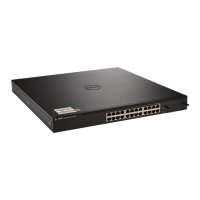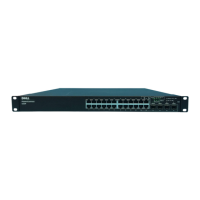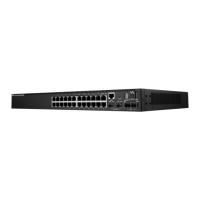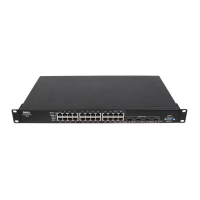Configuring Data Center Bridging Features 821
A port operating in the auto-downstream role advertises a configuration but is
not willing to accept one from the link partner. However, the port will accept a
configuration propagated internally by the configuration source. Specifically,
the willing parameter is disabled on auto-downstream. By default, auto-
downstream ports have the recommendation TLV parameter enabled. Auto-
downstream ports that receive internally propagated information ignore their
local configuration and utilize the internally propagated information. Auto-
downstream ports propagate PFC, ETS, and application priority information
received from the configuration source.
In the Configuration Source role, the port has been manually selected to be
the configuration source. Configuration received over this port is propagated
to the other auto configuration ports, however, no automatic election of a
new configuration source port is allowed. Events that cause selection of a new
configuration source are ignored. The configuration received over the
configuration source port is maintained until cleared by the operator (set the
port to the manual role).
Since it is not possible to configure the port role for a port channel, it is
recommended that the individual links have an identical port role configured
on all links in the port channel (auto-up or auto-down). Since only one port in
the system can be configured as the configuration source, configuring
interfaces as auto-up is a preferable alternative to a config-source setting.
Configuration Source Port Selection Process
When an auto-upstream or auto-downstream port receives a configuration
from a peer, the DCBx client first checks if there is an active configuration
source. If there is a configuration source already selected, the received
configuration is checked against the local port operational values as received
from the configuration source, and if compatible, the client marks the port as
operationally enabled. If the configuration received from the peer is
determined to not be compatible, a message is logged, an error counter is
incremented and the DCBx clients become operationally disabled on the
port. Operationally disabled means that FIP snooping and PFC will not
operate over the port. The port continues to keep link up and exchanges
DCBx packets. If a compatible configuration is later received, the DCBx
clients will become operationally enabled.
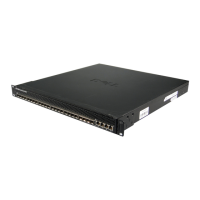
